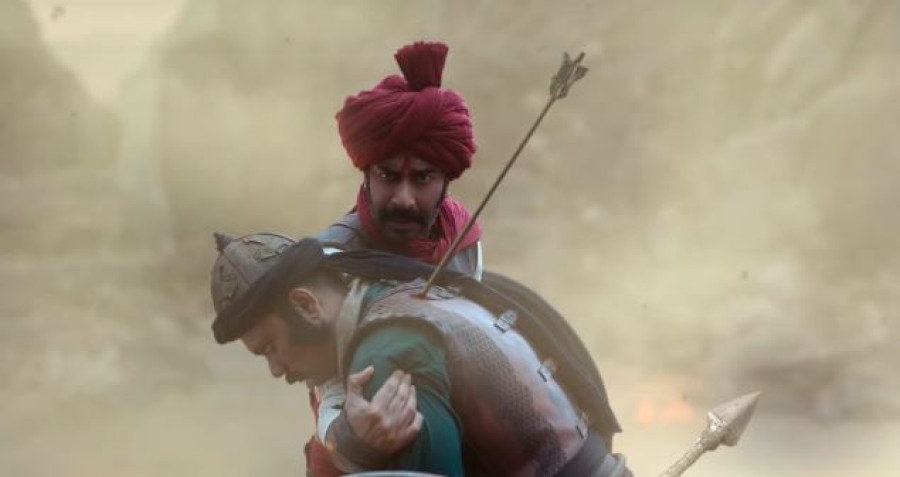Culture & Lifestyle
A crash course in Indian nationalist history from professor Devgn
Tanhaji is a historical epic that shoehorns religion into its tale of the battle between two macho males.
Abhimanyu Dixit
Remember history classes in school, or social studies classes? History, as most South Asians know it, is a peculiar brand of study where objective facts and happenings seem to originate out of folklore and religious scripture and where certain deeds and certain individuals are glorified. This is often an attempt to instil moral value or evoke a sense of patriotism. They’re even designed in a specific way, so as to not hurt any cultural or popular sentiments, and thus, to not create any controversy.
These are not the only problems with history in South Asia, because it can be dreadfully boring, with one-dimensional, non-human characters. Ajay Devgn’s new film Tanhaji: The unsung warrior continues in that same tradition.
Tanhaji Malusare (Devgn) was a real-life general in the court of 17th century Maratha emperor Chhatrapati Sivaji Maharaj (Sharad Kelkar). He is sort of like the Kalu Pandey to Prithivi Narayan Shah, and in the same way that Nepali textbooks describe Pandey, the film presents Tanhaji—the brave and good guy who battles against the odds. He is a religious devotee, a selfless warrior, a master of disguise, a loving husband, an honest patriot and skilled in guerrilla warfare. He is also a dear friend to the Maratha emperor.
Elsewhere, the Mughal Emperor Aurangzeb (Luke Kenny) rules over North India. Aurangzeb is portrayed here as evil, and that’s pretty much his only identity. He is so demented that he plays chess with actual humans, who must fight to the death. This evil emperor wants to expand his empire to South India and, to further his plans, he seizes a hilltop-fortress called Kondhana in Maratha territory.
Aurangzeb now sends his mightiest warrior, the sadistic Udaybhan Singh Rathore (Saif Ali Khan) to protect Kondhana. And if you thought Aurangzeb was bad, Udaybhan is worse. He takes pleasure in taunting and torturing prisoners, mercilessly beats his enemies with blunt objects, scalds people to death, roasts endangered species, and kidnaps a widow to watch her bathe. Basically, he’s supposed to be the stark opposite of all that Tanhaji is.
News travels fast to the Marathas that Udaybhan is travelling to Kondhana. He’s travelling with Naagin, the mightiest cannon in existence (read: a huge phallic object). If the cannon fires from Kondhana, the Maratha emperor and all his people will be obliterated. Sivaji now has to reconquer Kondhana at all costs, and the only man for the job is Tanhaji Malusare.
In terms of story, that’s all there is to it. We follow a battle of strategy and physical prowess between the good Tanhaji and the bad Udaybhan. The film is told through the Maratha perspective, equipped with extreme nationalism and all the cliché tropes of the genre. Does the hero’s best friend, or an important character, die a glorious death (usually in slow motion)? Yes. Does the strongest keep on fighting even as he is riddled with arrows? Obviously. And, before all the fighting, can you expect a rousing speech on the importance of motherland, sacrifice for the common good, one’s people, culture, and sovereignty? Take a guess.
The film is written by Prakash Kapadia and Om Raut, who is also the director. And the filmmakers insist on inserting religious politics into their film. In hindsight, this seems rather unnecessary because the film is about territory. Once the Muslim enemy is defeated, the film cuts to a temple with a celebratory bell ringing. They even use Hindu gods as a war cry. There are only two songs in the film, ‘Maai Vabhawani’ and ‘Shankara’ and both are about Hindu deities.
This film predominantly portrays Hindu-nationalist attitudes. Honestly, I don’t expect the Nepali audience to care much about any of it. The fate of the Maratha Hindus or the Mughal Muslims doesn’t really resonate with the contemporary Nepali audience. Perhaps we’d be interested and invested if this was about Prithivi Narayan Shah and Kalu Pandey. So why watch this film? For its entertainment value, of course.
If you disregard content—the one-dimensional storytelling, the nationalistic tone, and forced religious angle—you’ll find a proficient technical team. The film’s visuals, sound design, costumes, and location visual effects are masterful. They’re as good as any international historical epic, like 300, Game of Thrones or even Baahubali. I watched the film in 3D, and I was startled twice as I attempted to duck as arrows flew my way. I was especially impressed with the background score that amplifies the action, right from the opening sequence.
Cinematographer Keiko Nakahara’s clean framing allows you to follow everything without questioning anything. Nakahara especially chooses to stay wide often and employs long takes during fight scenes. This allows you to notice the intricate choreography and marvel at the lengths the actors have gone taken.
But ultimately, the film is all about the machismo of two male characters. This is Devgn’s hundredth film and he’s done similar roles before (remember Bhagat Singh?). Even though he’s also a producer in this film, don’t expect anything different.
Saif Ali Khan, however, has a playful approach to his Udaybhan, and is clearly the better performer. At times, he’ll make you feel guilty watching him taunt people for no reason. He can act psychotic, devastating and disgusting in the same shot. He’ll even make you laugh while he executes people.
But those are the male characters. The females play supporting roles. Neha Sharma plays Kamala Devi, a widow kidnapped by Udaybhan, and she’s only there to look pretty to sate
Udaybhan’s lust. She’s quite forgettable too, especially since we never actually learn what happens to her. She just vanishes mid-way into the film’s climax. Kajol gets more screen time, and deservingly so. She plays Tanhaji’s wife, Savitri, and it’s hard to take your eyes off her. She shines in scenes with Devgn, her real-life husband. In one instance, the husband and wife look into a handheld mirror and smile—an obvious selfie joke. She also gets a solo song sequence during the end-credit, even though Indian cinema audiences don’t really sit for the end credits.
Overall, the good news is technology has finally caught up to historic epics in India. I’m certain that the expertise and equipment will arrive here too, soon. In that regard, films like Tanhaji are a perfect reference for what to do in terms of technicalities, and what not to do in terms of storytelling. Nepal has a rich history, we have a plethora of interesting historical characters to choose from. If some of our social studies classes make it to the big screen, let’s hope the filmmakers focus more on designing three-dimensional characters.
Tanhaji: The Unsung WarriorStarring: Ajay Devgn, Saif Ali Khan, Kajol
Cinematographer: Keiko Nakahara
Director: Om Raut2.5 out of 5




 23.24°C Kathmandu
23.24°C Kathmandu















